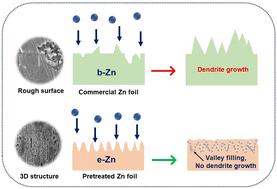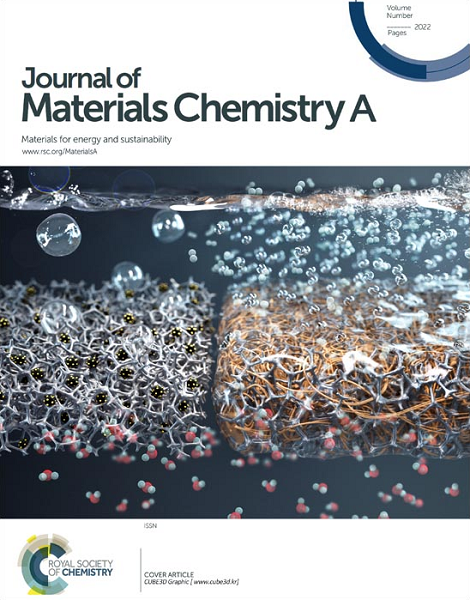Beyond conventional: unveiling the impact of Zn anode pretreatment in aqueous zinc-ion batteries
IF 10.7
2区 材料科学
Q1 CHEMISTRY, PHYSICAL
引用次数: 0
Abstract
Despite the simplicity and widespread use of conventional (untreated) Zn foil as a benchmark, conventional Zn foil continues to be the most common anode material in the research of zinc-ion batteries (ZIBs). However, there has been little focus on the inherent structure of the zinc foil itself. The traditional Zn anode has uneven rough surfaces that can lead to nonuniform charge distribution and hinder nucleation, thereby triggering the “tip effect” that can induce the formation of adverse dendrites. In this study, the conventional Zn foil was examined using simple pretreatments such as mechanical polishing and chemical etching that have the potential to substantially improve the electrochemical properties. Compared with bare Zn (b-Zn) and polished Zn (p-Zn), chemically etched Zn (e-Zn) sustained a remarkable life cycle of up to 5000 cycles with ∼71% cycling retention at a high current density of 5 A g−1 using V2O5·nH2O as a cathode material. Besides, the e-Zn‖e-Zn symmetric cell exhibited excellent cycling stability over 300 cycles at a high current density of 10 mA cm−2 with better inhibiting hydrogen production during Zn stripping/plating. Moreover, advanced characterizations such as in situ transmission X-ray microscopy (TXM) and ex situ atomic force microscopy (AFM) have been employed to gain insight into the early stages of Zn dendrite formation on Zn foils in mild acidic aqueous electrolytes during the plating/stripping processes. This superior performance of the e-Zn is attributed to its unique 3D structure that effectively accommodates Zn dendrites, as confirmed by XRD and EBSD analyses, which reveal Zn deposition along the (002) plane with lower surface energy as compared with other planes. This approach provides a straightforward and industrially scalable method for expanding ZIB utilization.

超越传统:揭示锌阳极预处理对锌离子水电池的影响
尽管传统(未经处理的)锌箔简单易用且广泛用作基准,但在锌离子电池(ZIB)的研究中,传统锌箔仍然是最常见的阳极材料。然而,人们很少关注锌箔本身的内在结构。传统的锌阳极表面粗糙不平,会导致电荷分布不均匀,阻碍成核,从而引发 "尖端效应",诱发不良枝晶的形成。在本研究中,采用机械抛光和化学蚀刻等简单的预处理方法对传统的锌箔进行了检验,这些方法有可能大大改善其电化学特性。与裸锌 (b-Zn) 和抛光锌 (p-Zn) 相比,化学蚀刻锌 (e-Zn) 在使用 V2O5-nH2O 作为阴极材料的 5 A g-1 高电流密度条件下,可维持长达 5000 次循环,循环保持率高达 71%。此外,"e-Zn"-e-Zn 对称电池在 10 mA cm-2 的高电流密度下循环 300 次以上,表现出卓越的循环稳定性,并能更好地抑制 Zn 剥离/电镀过程中的氢气产生。此外,还采用了原位透射 X 射线显微镜(TXM)和原位原子力显微镜(AFM)等先进的表征技术,以深入了解在电镀/剥离过程中,锌箔在弱酸性水电解质中形成锌枝晶的早期阶段。XRD 和 EBSD 分析证实,e-Zn 的优异性能归功于其独特的三维结构,这种结构能有效容纳锌枝晶,XRD 和 EBSD 分析表明,与其他平面相比,锌沿表面能较低的 (002) 平面沉积。这种方法为扩大 ZIB 的利用率提供了一种直接且可在工业中推广的方法。
本文章由计算机程序翻译,如有差异,请以英文原文为准。
求助全文
约1分钟内获得全文
求助全文
来源期刊

Journal of Materials Chemistry A
CHEMISTRY, PHYSICAL-ENERGY & FUELS
CiteScore
19.50
自引率
5.00%
发文量
1892
审稿时长
1.5 months
期刊介绍:
The Journal of Materials Chemistry A, B & C covers a wide range of high-quality studies in the field of materials chemistry, with each section focusing on specific applications of the materials studied. Journal of Materials Chemistry A emphasizes applications in energy and sustainability, including topics such as artificial photosynthesis, batteries, and fuel cells. Journal of Materials Chemistry B focuses on applications in biology and medicine, while Journal of Materials Chemistry C covers applications in optical, magnetic, and electronic devices. Example topic areas within the scope of Journal of Materials Chemistry A include catalysis, green/sustainable materials, sensors, and water treatment, among others.
 求助内容:
求助内容: 应助结果提醒方式:
应助结果提醒方式:


